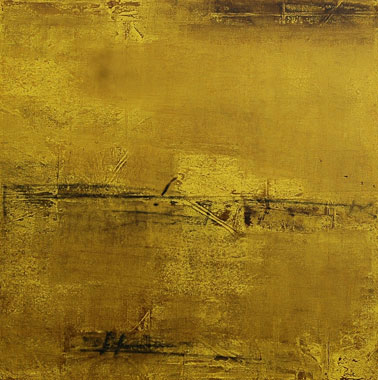Shaul Tchernichovsky Hebrew Poet.
To say that the work of Nitin Dadrawala has matured over the decades would be to state the obvious. He has been consistently exploring the landscape of his canvas. He has experimented with oils and pastels, delved in calligraphy and etching. The current set of works is a return to the spaces Nitin has been working on for several years. These monochromatic spaces have been evolving and deepening, acquiring more texture over time, like the lines on an old man’s face. One has to admire Nitin’s unswerving dedication to the art of the abstract.
The spaces on the canvas are refracted through the artist’s imagination and ideas. In some cases, the surface assumes the characteristic of a fresco or cave painting, a suprematist landscape in others – stars being formed, the deep space exuding a hazy light of the cosmic explosion. There is an exploration of color, the moods and atmosphere it evokes. Within the color field, there appear boundaries – sky and earth and ocean. Groups of dots appear, dark shadings, quasi-geometrical shapes : a floating sea-plant sprouting roots, in other places indications of decay, effects of time and erosion. Elsewhere, rectangular patches invite reflections on the materialistic aspects of the tools and pigments used. At times one sees the emerging of a latent image, slowly making its appearance from the background.
When Nitin talks about his own work, there are references to Zen. The paintings do not, figuratively, allude to his influences. Instead, a sense of inhabiting the moment pervades the works; there is a stillness that is very palpable. The artist is inviting us to look at his world, one that is at once enigmatic and evocative. The painting is what we make of it, the sum of experience and vision we bring to it. The minimalism here inspires us to project from the cinema of our memory, the theater of our imagination onto the surface of the painting.
Beyond the philosophical ideas they might imbue, the paintings can be appreciated for what they are: a dance of color, texture and line. The plane of the canvas can be seen as a retentive membrane, as critic Kenneth Baker calls it, which allows the artist to communicate a shared mood and feeling with us. The markings provoke us to question their place in the canvas. The final results are a by-product of an evolved, tightly controlled process, but accidents of material and technique are as much part of the creative process.
It has been exciting to follow Nitin’s journey to date.
– Nandan Joshi.

